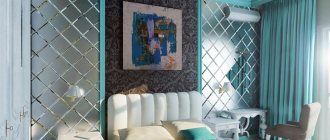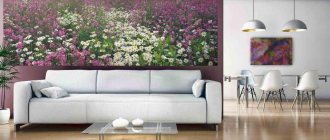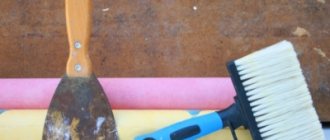What is special about mirror tiles as a decorative material?
Reflective finishing is an original and beautiful raw material that is ideal for rooms with limited space or poor lighting. The right material can hide imperfections on surfaces and become a striking design element.
Mirror tiles look more decorative than traditional ceramics.
Finishing with reflective properties is made using different technologies. Based on the type of raw material, decor is divided into 5 types:
- Glass. Special substances are added to the molten mass, which give the finish a mirror shine.
- Acrylic. Lightweight material is not afraid of mechanical and chemical stress. Used to decorate furniture and ceilings.
- Ceramics. The composition includes clay, quartz dust and plasticizers. Externally, the decor resembles precious metals, used for cladding walls in the kitchen.
- PVC. Durable, flexible tiles are easy to install and are suitable for finishing ceilings and creating panels.
- Porcelain tiles. Luxurious material with a perfectly smooth surface is very strong and durable. Used in rooms with constant high humidity.
Ceiling lining
Mirror tiles on the ceiling give the illusion of increasing space, filling it with air. Often the ceiling in the hallway is decorated with mirror tiles. For the best effect, combine opaque and mirror tiles.
It is recommended to select more ceiling material, the higher the ceiling. But you should not use only large tiles: you get the feeling of an uninhabited, cold room. It is optimal to combine mirror slabs and panels imitating natural stone or wood.
Large slab sizes make the seams noticeable, increasing the likelihood of splitting. The image on large tiles is often distorted and dirt is noticeable. And large mirror planes do not always fit into the design of the room.
It is ideal to decorate the ceiling with small tiles and panels. According to the configuration, the mirror ceiling can be square, circular, or diamond-shaped.
It is advisable to use dark colors for framing. The design becomes non-standard and warm. The mirror base of the ceiling is in harmony with cork, wood decor and in the bedroom.
A cornice made of mirror materials will highlight the ceiling perimeter. The room will visually expand, and the transitions of horizontal surfaces will become invisible.
Types of mirror tiles in the interior
There are different types of mirror tiles in the interior. Before making your final choice, you should understand the available options:
- Standard. Has a smooth, even surface. The joints of the product are practically invisible.
- With facet. It is easy to install.
- With a metallic effect. The surface can be silver, gold or imitating chrome and bronze.
- Tinted. Characterized by the presence of a weak tone.
- With ornament. During production, the sandblasting method is used, which makes it possible to obtain various designs.
- Decorative. In addition to the presence of a pattern, there are three-dimensional designs or a textured base.
Production and technical specifications
Mirror tiles are made differently from classic ceramic tiles. This is due to the structural features of the product. The manufacturing process of such material is automated. The warp is made by cutting large sheets into uniform segments of the desired shape and size. The mirror side is made using the damping method. Crystalline substances are added to glass melted at high temperatures, due to which a characteristic shine appears. The cut fragments are processed on a grinding machine and polished.
If the tiles are made from polystyrene, they are much easier to cut and paint. However, this option is no longer so environmentally friendly and safe. All designs and ornaments on surfaces are applied by sandblasting.
Main types
Even tiles made from the same material can differ significantly from each other. Among the most popular options are:
- Smooth mirror tiles without any relief. When laying it, the joints are almost invisible, which makes it possible to create a solid mirror surface, not limited by the shape of a standard mirror. This finish will fit perfectly into modern interior styles (high-tech, minimalism).
- With facet. A slight bevel of the edges (chamfer) of such mirror tiles greatly facilitates installation, but most of all this type is valued for its ability to create a complex surface that reveals the full potential of the interior. Mirror tiles with bevels look expensive and elegant in the interior, giving any room a noble and luxurious look, and the light refracted on the edges creates a lot of glare.
Ideally, such decor will complement classic interiors, especially those made in the palace or baroque style, as well as neoclassical and eclectic
- With imitation of a metal surface. Polished bronze, copper, silver, gold, chrome will fit perfectly into both modern and classic interiors. There may be patina or other “traces of time” on the surface.
- Tinted mirror tiles, in which the color of glass or amalgam can be any shade - from smoky gray or beige to rich pink or black.
- With an image. All kinds of ornaments, designs and patterns on such tiles are obtained by sandblasting or using a laser. This option will give the interior individuality and expressiveness.
- With a textured surface. Volumetric designs, pronounced texture or unusual relief will serve as an ideal decor for a wide variety of interiors.
Advice! You should not overuse the abundance of mirror surfaces in the house, this can have a depressing effect on the psyche, causing irritation and anxiety. A room with a lot of reflections will be uncomfortable.
Care Tips
Tiles with a mirror surface are easy to use and care for on a daily basis. It should be wiped regularly with a damp cloth. To avoid streaks, you need to use not just tap water, but special mirror cleaners or table vinegar.
After treating with these compounds, you need to wait a little, and then rinse them off with ordinary running water, and then wipe the surface with a dry rag or cellulose napkin.
Do not rub the mirror surface with hard sponges, as this can cause the tile to become deformed and become scratched.
In bathrooms, mirror tiles and the joints between them can sometimes be treated with special antifungal compounds. Otherwise, caring for this material is no different from caring for ceramic tiles or mirrors.
If dust and dirt appear on the mirror tiles, they can be easily washed with a regular glass cleaner. The matte surface should be cleaned with plain water and vinegar. For severe stains, cleaning agents for removing limestone are suitable.
Composition Basics
To make the interior look harmonious, it is better to use mirror tiles to focus attention on one of the walls or ceiling, column or wall. In this case, reflective elements can occupy both the entire area and individual areas.
Advice! For mirror tiles to work to attract and reflect light, they should be placed opposite windows, lamps, and supplemented with lighting.
An interesting effect can be achieved if you cover adjacent surfaces with mirror tiles, for example, a wall and a ceiling or two adjacent walls. But in this case, it is recommended to use products of different types (faceted and contrasting shades, or smooth and patterned).
Finishing using mirror tiles should be done taking into account that a minimum of objects are reflected, otherwise it will not be possible to visually expand the space, giving it lightness; on the contrary, it will create a cluttered effect.
In order not to overdo it with mirror tiles, it is recommended to combine them with other materials.
For example, wall decoration can be done in the form of a checkerboard or honeycomb, where mirrors alternate with wood, ceramics, cork, metal, and stone.
Advantages and disadvantages
Like all finishing materials, mirror tiles have a number of pros and cons that are worth knowing about. Let's start with the good:
- The material is moisture resistant, which makes it ideal for use in rooms with high humidity;
- Fire safety - the material does not support the combustion process;
- The surface is resistant to alkalis and acids;
- Easy to care for;
- Long service life subject to installation technology and normal indoor conditions;
- Stunning decorative properties, which include not only the originality of the idea itself, but also the attractive and unusual appearance of the surface lined with this material;
- And most importantly, the ability to model space. In other words, if used correctly, you can visually enlarge a small room - “push apart” the walls and even raise the ceiling level.
Now about the disadvantages:
- The material is very brittle and its edges are prone to chipping. This cannot be avoided if installation and transportation are not carried out carefully;
- If mirror fragments are incorrectly positioned on different surfaces, a labyrinth effect may occur, which has a depressing and overwhelming effect on the human psyche;
- The surface is easily scratched and does not tolerate contact with abrasive substances;
- If the room is poorly ventilated, the surface of the tiles may darken over time.
As you can see, the disadvantages are easily removable and can only arise from ignorance of the features of working with this material. Choose trusted sellers who value their reputation and take care of their own products.
This can ensure that the cargo is individually packaged and insured during transport.
This means you, in turn, will be safe and insured against purchasing damaged goods. The installation of tiles can be entrusted to experienced professionals who provide a guarantee for their work.
Mirror ceiling tiles in the interior
“Now this may sound strange, but sometimes mirrored ceiling tiles can, instead of having the effect of expanding space, produce a radically opposite effect, that is, narrow it.”
Mirror tiles can be classified as unique finishing materials, because they really allow you to turn all sorts of decorative delights into reality. By covering the ceiling of any room with mirror tiles, you will make its decor lighter and more elegant.
But the mirror does not tolerate frivolous treatment, so its use in the design of premises must be done according to certain rules.
If you need to increase the space, then the mirror tiles should appear on the side of the ceiling opposite the window. It can cover it completely or have the appearance of a mirror panel. How to decide which option to go with? There won't be any problems here.
There is an axiom that says that finishing of this type should not be exposed to the rays of the sun, otherwise it will simply be impossible to stay in the room due to the incredible amount of blinding glare. It follows from this that it is better to lay out a mirror panel in a sunny room.
Now this may sound strange, but sometimes mirrored ceiling tiles can, instead of having the effect of expanding the space, produce a radically opposite effect, that is, narrow it. This will become possible if the tiles are laid out on the surface not as a single sheet, but as separate inserts, which will be diluted with combinations of materials of other textures.
This will look incredibly impressive in spacious living rooms, for example, or hallways, but in other cases it is better not to resort to this technique.
On the ceiling, it is generally advisable to make a smooth mirror surface, without unnecessary joints and seams. This ceiling will look just great. You can only lay out certain areas with mirrored ceiling tiles. This technique will also allow the room to “grow up”.
If you don’t like the idea of reflection in the ceiling, but still need to increase the height of the room, then use mirror tiles when decorating the lower part of the walls. In this case, the decorative effect will be the same.
Photo in the living room
If the living room is zoned with a multi-level ceiling, it would be appropriate to decorate some parts of it with mirror tiles. Another interior design idea is to completely tile one of the walls. This will expand the room and highlight its details.
You can also use the property of mirrors to double nearby objects. Place several indoor plants near the wall decorated with mirror materials - it will seem that there are many more of them. A glass display case with beautiful dishes, placed near a mirrored wall, will also “double.”
The photo shows a living room interior in a classic style; mirror surfaces help to visually enlarge a small space.
In what rooms is it appropriate to use
If you have definitely decided for yourself that there should be such an element in your apartment, it’s time to decide in which room you should place such decor and in which not. Let's start with the main thing - there is no place for mirror tiles in the interior of a children's room. Let’s immediately answer the question “why?”:
- This material is quite easy to break, crumble into small sharp pieces and cause injury. Even if you are not using real glass, but plastic, its fragments can also be very dangerous.
- A child will definitely not be able to appreciate a fashionable and modern trend for the first 15 years. This means that you are doing this exclusively for yourself. In this case, place a mirror panel in your room.
- A child's unstable psyche may have ambivalent perceptions of such a technique. The child's reaction can be unpredictable.
- From a comfort point of view, this is not the “warmest” material for decorating a child’s room.
- In all other rooms you don’t have to limit your own imagination.
In the kitchen
Mirror tiles in the interior of a room are used to visually change the area. Installation on a surface from ceiling to floor will create the effect of a visual increase in the room by 2 times. When facing two opposite walls, a narrow space takes on a regular geometric shape. If you decorate the ends, you can easily lengthen the kitchen.
A mirrored ceiling or floor will make the room feel larger. To avoid dizziness, the decoration is used only on one element. Reflective surfaces create the visual effect of additional space hidden behind the glass finish.
Mirror tiles frame furniture facades, columns and doors in the kitchen.
Decoration visually enlarges the room and adds a touch of luxury to the interior. Decor in the form of mosaics or elements of relief, colored decoration can be inserted into a picture and hung on the wall.
Mirror material of different sizes helps to adjust the height of the kitchen. Large tiles are installed at the bottom, small ones - closer to the top. The decor looks original when installed in a corner or diagonally. The installation method allows you to visually expand the boundaries of the room.
Walls with reflective finishes increase the amount of natural light in the space. If the decoration is placed opposite the window, the incoming rays will be evenly distributed throughout the room. In a small, dark kitchen, designers recommend tiling the area under the chandelier with mirror tiles.
In the interior of the cooking room, finishing is used when decorating the dining room. Decor helps increase lighting and improves zoning. The height of reflective elements should not cut off the heads of people who are eating, otherwise psychological discomfort will occur.
Mirror tiles look luxurious when framed by a backsplash. This design technique will visually expand the kitchen space and allow you to observe what is happening behind you. Both the mosaic with a reflective effect and large elements (“bricks”) with a pronounced bevel look unusual.
Mirror finishing material is suitable for decorating the work area. If there are many open areas on the walls in the room, then the voids are filled with tiles or solid sheets. The technology visually pushes the partitions apart, increasing the size of the room.
To prevent the surface of the raw material from fogging up during cooking, you need to ensure high-quality ventilation.
In the hall
In a limited corridor space, finishing material allows you to correct an incorrect layout and hide defects on the walls or ceiling. The room visually seems more spacious. The mirror tiles reflect the light from the lamps and make the dark hallway more cozy.
To change the shape of a long vestibule, decor is applied to one of the walls. The material covers the surface completely or partially, creating an expansion effect. The elements are combined with a light background design. Mirror tiles in the interior of a square corridor occupy the end area next to the door.
In the spacious entryway, reflective trim enhances the beauty of the design. Niches decorated with beveled material, engraved or tinted, look luxurious. Glossy solid canvases are used to decorate the space-columns between the entrances to the room or areas in niches.
Reflective inserts on the ceiling allow you to increase the dispersion of light from the chandeliers.
The disadvantages of finishing include the soiling of the mirror surface. In the corridor, areas around the floor and at the level of a person’s hips are considered problematic. To minimize contamination, designers advise lining the upper parts of the walls or using tinted finishes.
In the living room
The material in the hall helps change the perception of space. Beautiful raw materials allow you to give the room the desired volume, depth and relief. Correctly placed elements reflect artificial and natural light, making the room bright and cozy.
Mirror tiles in the living room interior add a touch of luxury to the design. Panels assembled from “honeycombs” or small mosaics look impressive. The decorative element is perceived as an additional window. If you place lighting fixtures nearby, soft reflections will appear on the surface.
Mirror tiles are used to decorate empty areas. Behind the TV, fireplace and open shelves, designers recommend installing beveled trim in the shape of a diamond.
Instead of paintings, you can hang a panel of squares above the sofa. A visual effect is created of continuation of the space behind the sheathing, which enlarges the small living room.
Accent walls decorated with mirror tiles look luxurious. The mood of the interior depends on the type of finishing used by the designers:
- Grace. Facet types fit harmoniously into the symmetry of the classics.
- Strictness. Glossy seamless versions of simple geometric shapes will complement the design of living rooms in modern directions (high-tech, minimalism, Scandinavian).
- Luxury. Mosaic, elements with relief, patterns and tinting resemble a huge painting, suitable for Art Nouveau, Empire, and Art Deco styles. Tile designs range from polygons and squares to ovals and semicircles.
- Originality. The polished graphite surface will add noticeable accents to a room in gray and black tones.
In a small room, mirrored tile inserts will help visually adjust the room.
A horizontal arrangement makes the space wider, while a vertical arrangement raises low ceilings. The finishing is installed in pairs symmetrically or single components are used in problem areas.
The abundance of mirror details makes the interior cold. To avoid irritating decor, we recommend not installing identical reflective elements on opposite walls. When facing, glossy and patterned, matte and embossed types are combined.
In the bedroom
Mirror finishing brings a touch of luxury to the interior of the sleeping room. Unlike the living room and kitchen, you need to carefully use decorative material in the bedroom. With double reflection, a “tunnel effect” will occur, which creates psychological discomfort during rest. The tiles should not be installed on opposite walls or in nurseries.
When decorating a bedroom, mirror finishes are often used on the ceiling. A design technique allows you to increase the illumination of the room. The rays are reflected from the glossy surface and distributed evenly throughout the room. In space you can use both seamless fabrics and facets.
To reduce the feeling of discomfort, it is recommended to install mosaic, tinted or satin options above the bed.
In the sleeping area, mirror tiles are installed at the head of the bed. Elements with a pattern that is repeated in textiles or on furniture facades look original. Sandblasting makes the decor more elegant and luxurious, reducing discomfort from reflective properties.
A mirror panel is often used at the head of the bed. A decoration of several large squares in any shape is placed on the wall. Small glossy mosaic tiles that descend in the form of drops along the surface look unusual. From the honeycomb trim you can assemble a luxurious flower or sun.
Mirror inserts from the ceiling to the floor are appropriate on the sides of the bed. This design technique allows you to visually elongate a low room.
Facet diamonds are placed next to the bedside tables. To improve the lighting of the space, sconces are additionally installed. When the lamps are turned on, the rays are reflected from the gloss and distributed throughout the room.
The mirrored headboard that flows into the ceiling looks unusual. The element creates zoning for the bedroom and improves lighting. Diamonds, “honeycombs” or “shards” are appropriate for decoration. If vacationers experience discomfort from reflective finishes, then use embossed, satin elements or options with patterns.
A mirror surface can not only enlarge a room, but also visually narrow it. In a huge bedroom, designers often combine reflective finishes with regular tiles. The fragmented elements distribute lighting well, while making the room cozy.
A mirrored wall can be placed opposite the bed. The facing material is used on the surface behind the TV and in empty areas of the shelves.
The reception creates the feeling of an extension of the room. A coating with a diamond-shaped bevel or figured tiles with noticeable (contrasting) seams looks original.
The reflective properties of the material are used when creating accent walls. A huge surface from floor to ceiling can replace a traditional mirror. A cosmetic table and chair are installed nearby. The decor in the form of ovals, honeycombs and rectangles with wide seams looks unusual.
In the bathroom
The finishing material allows you to create an elegant, sophisticated interior in the bathroom. Reflective tiles will visually add depth, light and volume to a room. The right design will help reveal the beauty of style in a limited bathroom space.
In conditions of high humidity, the decor fades and loses its shine, so they additionally provide good ventilation.
Indoors, designers use full wall cladding. Mirror material can transfer to the ceiling, visually increasing the height. In the absence of natural light sources, lighting is improved with the help of lamps, lamps and sconces. The rays are reflected from surfaces, spreading throughout the bathroom.
Mirror tiles in the bathroom interior are often combined with ceramics of the same size. Glass and black squares arranged in a checkerboard pattern look original. When facing with rectangular elements, a herringbone laying is used.
The darkness of dark tones is minimized by reflective details. Designers recommend combining glossy and textured surfaces.
Partial cladding technology allows you to correct the shortcomings of the room. Angular laying of mirror tiles (at the joints of walls) will visually raise the ceiling and expand the partitions. Vertical inserts (“columns”) make the narrow space look square. If there are niches in the room, then they must be decorated with reflective material and supplemented with fluorescent tape.
Small beveled tiles look elegant. The mosaic is laid around the perimeter of the mirror or framed around the area near the countertop. Light is refracted in the beveled edges, which fills the room with soft “bunnies”. If you use colored reflective details, the shade will add warmth to the coldness of the design.
A tile panel will become a bright accent of the interior. The decoration is placed next to the bath bowl or instead of a regular mirror. In a large room, an abstraction made from large glossy elements or partially coated options looks luxurious. In a compact bathroom, designers advise using mosaic views and “shards”.
Reflective finishes on the ceiling should not be combined with mirrored floor decor.
If owners suffer from dizziness, then the decoration will cause discomfort. Designers recommend lining the area near the central lamp, and below, combining raw materials with ceramics or granite options.
Features of self-installation
It is quite possible to install the material yourself. First you need to choose the right glue. Ordinary cement is not suitable for mirror tiles, as it destroys the amalgam. Construction stores sell special compounds (usually resin-based) that provide good adhesion between the surface and fragments, without harm to the latter. Now you can start preparing the wall. Remains of wallpaper or paint are removed from it. There should not be a trace left of the previous coating. Minor defects are corrected with plaster. Drywall will help cope with serious irregularities. This nuance is very important, since bumps and dents will certainly appear on the seams between the tiles, which will give the decor a sloppy look. To ensure better adhesion, it is recommended to prime the surface before installing the mirrors. If the work is not carried out in the most favorable conditions (high humidity), then it is better to treat the wall with antifungal compounds. After the primer has completely dried, you can begin marking. Using a tape measure and a pencil, mark the location of the tiles on the wall to make the work easier. Start from the bottom corner. The rows are laid out sequentially. Corrections are made immediately. Glue is generously applied to the back of each tile. After a couple of minutes, the fragment is applied to the wall and pressed lightly. After the glue has dried, the joints are grouted. Then the tiles are thoroughly washed. If fragments need to be cut, use a simple glass cutter.
In the bathroom and kitchen, where temperature fluctuations are regular, a “technical” gap of 2 mm is left between the fragments. This reserve is necessary in case the surface of the base expands due to heat.











